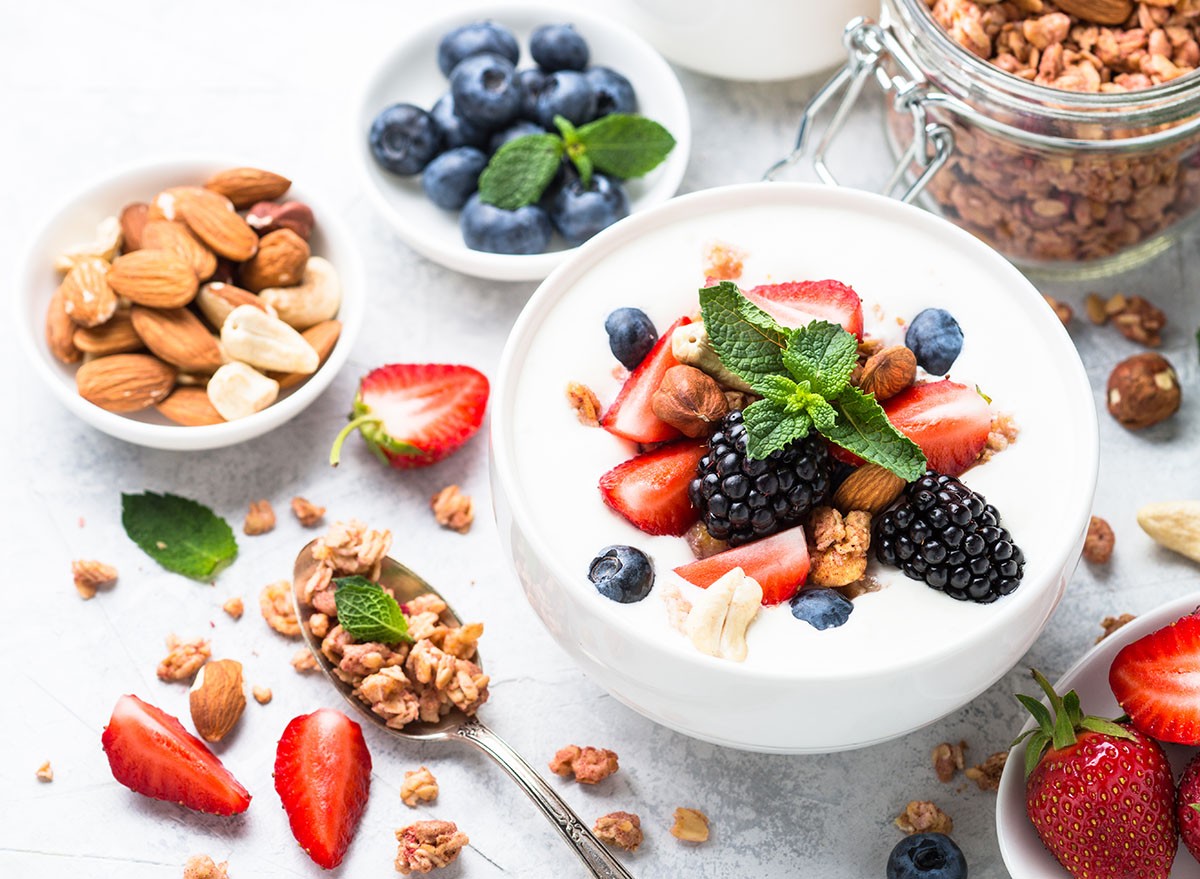5 Morning Habits That Burn Belly Fat in 30 Days According to an Expert

Do you wake up feeling tired, only to struggle with cravings and low energy all day? Your morning routine might be sabotaging your weight loss efforts. Dr. Tony Hampton, a board-certified Family and Obesity Medicine specialist, reveals five science-backed morning habits that can transform your metabolism and help you finally achieve sustainable fat loss. Read on to discover simple changes that could revolutionize your weight loss journey.
Hydrate the Right Way
The very first thing you should do when waking up isn't checking your phone or grabbing coffee – it's hydrating your body. "After six to eight hours without fluid, dehydration slows your metabolism, increases hunger hormones, and makes your body cling to fat instead of burning it," Dr. Hampton explains in his post.
Morning dehydration can significantly impact your metabolism. "When you wake up, your body is in a dehydrated state after hours without water," Dr. Hampton points out. This state of dehydration directly affects your body's ability to burn fat efficiently.
But it's not just about drinking plain water. Dr. Hampton recommends adding a pinch of high-quality sea salt or electrolytes to replenish minerals lost overnight and support adrenal function. "If you really want to supercharge fat burning, add a squeeze of lemon for a natural liver detox or a splash of apple cider vinegar to support insulin sensitivity," he suggests.
The benefits of this strategic hydration are immediate. "Within minutes, your metabolism wakes up, digestion improves, and you're less likely to experience cravings and energy crashes later in the day," says Dr. Hampton. He also emphasizes the accessibility of this habit: "What's cool about water is that it's simple, powerful, and completely free."
Get Natural Light in Your Eyes

Within the first 30 minutes of waking up, try to expose your eyes to natural sunlight. "Your metabolism is directly tied to your circadian rhythm, the body's internal clock that regulates hormones like cortisol, insulin, and leptin," says Dr. Hampton.
This often-overlooked habit has tremendous impact on fat loss. Dr. Hampton notes, "When your eyes detect natural light, your brain gets a signal to lower melatonin and increase wakefulness hormones, which helps regulate blood sugar, reduce cravings, and optimize energy."
The morning light exposure does more than just wake you up. "It tells your body that it's time to be active, making you more likely to burn fat efficiently throughout the day," Dr. Hampton explains. The time commitment is minimal for significant benefits.
"Even just five to 10 minutes of morning sunlight without sunglasses can improve your metabolic rate, increase focus, and help you sleep better at night, which is critical for fat loss," he advises. For those with limited access to morning sunlight, Dr. Hampton offers an alternative: "If you live in a place where morning sun isn't always available, or you're an early riser like me, using a bright light therapy lamp for a few minutes can have similar benefits. Just make sure that the light has at least 10,000 lux."
Front-Load Your Protein

The Breakfast Mistake Most People Make
One of the biggest morning mistakes is starting your day with carbohydrate-heavy foods. "One of the biggest mistakes people make is starting their day with a carbohydrate heavy meal like grits, oatmeal, cereal, or toast," Dr. Hampton warns. The consequences are immediate and counterproductive to weight loss goals.
"All of that starch, starch, starch will raise your sugar, sugar, sugar. This blood sugar spike causes an insulin surge and leads to mid-morning hunger and, unfortunately, fat storage," explains Dr. Hampton. This pattern sets you up for a day of cravings and energy crashes.
The Protein Solution
Dr. Hampton has a clear alternative: "If you want to lose weight, you need to front load your protein." This simple shift in your breakfast approach can dramatically change your body's fat-burning potential.
"Protein first thing in the morning is the most effective way to control appetite, increase muscle protein synthesis, and trigger thermogenesis, meaning your body burns more calories just digesting it," Dr. Hampton explains. The amount matters, too.
"In my clinic, I recommend my patients get at least 30 grams of protein within the first 90 minutes of waking up," he shares. Getting this much protein doesn't have to be complicated. "This can come from eggs, sausage, bacon, or even a high-fat, low-sugar Greek yogurt with nuts may do the trick for some of you guys," suggests Dr. Hampton.
RELATED: 8 High-Protein Foods with Nearly Zero Calories That Melt Fat
How Protein Changes Your Day
The benefits of a protein-rich breakfast extend well beyond the morning. "It stabilizes blood sugar, reduces cravings, and makes you naturally eat fewer calories throughout the day," Dr. Hampton points out. There's also a significant mental benefit.
"Protein increases dopamine levels, helping you feel more focused and motivated, critical to sticking to your weight loss plan," he adds. For those who have struggled with inconsistent results, Dr. Hampton offers encouragement: "If you've been struggling with hunger, fatigue, or constant snacking, this one change could be the key to finally seeing results."
Move Before You Eat

Getting some movement before your first meal can significantly boost fat loss. "Fasted movement forces your body to tap into stored fat for energy instead of relying on glucose," says Dr. Hampton. The good news is that this doesn't require a strenuous workout regimen.
"I'm not saying you need to do an intense workout first thing in the morning, but even just a 10 to 15 minute walk, some light stretching, or body weight exercises can make a huge difference," Dr. Hampton reassures. The science behind this approach is compelling.
The Science of Fasted Movement
Dr. Hampton explains the metabolic mechanism at work: "This works because movement in a fasted state increases fat oxidation, the process where your body breaks down fats like triglycerides into smaller molecules like free fatty acids, which can then be used as energy by the body, primarily occurring within the mitochondria of your cells."
This process aligns with your body's natural preferences. "Did you know that your body prefers burning fat as fuel? That's right. Your body prefers burning fat as fuel," Dr. Hampton emphasizes. Beyond immediate fat burning, there are longer-term metabolic benefits.
"Fat oxidation also improves insulin sensitivity, making your metabolism more efficient for the rest of the day," he explains. This creates a positive cycle that supports continued weight loss.
Options for Different Schedules
Dr. Hampton acknowledges that everyone's morning routine and fitness level differ. For those with more time, he suggests: "For those of you who have time in the morning, adding in resistance training or short bursts of high intensity movement like jumping jacks, pushups, or squats can further amplify the fat burning effect."
Even for those with minimal time, there's still a way to benefit. "If you're someone who can't workout in the morning, at least aim to walk five to 10 minutes before breakfast," advises Dr. Hampton. He emphasizes the long-term impact of this simple habit: "The difference it makes in long-term fat loss is incredible."
Control Your First Dopamine Hit

The final morning habit focuses on protecting your brain chemistry. "If you can't control your first dopamine hit of the day, you set yourself up for cravings, low energy, and decision fatigue later on," Dr. Hampton cautions.
The Modern Morning Trap
Most people begin their day with activities that create unhealthy dopamine patterns. "Most people start their day by scrolling their phone, checking emails, or consuming highly stimulating content," Dr. Hampton observes. The consequences extend well beyond just the morning hours.
"The problem? This floods the brain with dopamine first thing in the morning, making it harder to resist junk food, emotional eating, and even binge watching TV later on," he explains. This neurological pattern creates a day of struggle against cravings and poor choices.
Building Dopamine Resilience
Instead of starting with high-dopamine activities, Dr. Hampton recommends alternatives that set you up for success. "Instead, you want to start your morning with something that naturally regulates dopamine, like writing in your journal, meditation, reading, or even just sitting in silence with your coffee," he suggests.
These calmer activities have profound benefits for your weight loss journey. "By doing this, you build resilience to cravings, improve focus, and make it easier to stick to your fat loss goals," Dr. Hampton explains. The impact of this mental preparation extends throughout your entire day.
"Think of it this way. If you can win the first hour of your day, you can win the next 23," Dr. Hampton affirms. This approach to dopamine management creates a foundation for better decisions all day long.
Start Small for Big Results

Creating new habits doesn't happen overnight, and Dr. Hampton encourages a gradual approach. "Imagine how different your body would feel if, starting tomorrow morning, you hydrated strategically, got natural light in your eyes, prioritized protein, moved before eating, and controlled your dopamine," he suggests.
The key is to start with manageable changes. "You don't need extreme things to make a big change. You just need to change your habits, one morning at a time," Dr. Hampton advises. This approach prevents the overwhelm that leads many people to abandon their weight loss efforts.
Dr. Hampton recommends beginning with just one habit: "Pick one of these habits and start tomorrow." This incremental approach makes lasting change much more achievable than trying to overhaul your entire routine at once.
Working With Your Body, Not Against It

The fundamental principle behind these morning habits is cooperation with your body's natural processes. "The more we understand how to work with our bodies instead of against it, the easier fat loss becomes," Dr. Hampton explains.
This perspective shift—from fighting your body to supporting its natural functions—makes weight loss more sustainable. Rather than extreme diets or punishing workout regimens, these habits enhance your body's inherent fat-burning capabilities.
By implementing these science-backed morning routines, you're creating the optimal conditions for your metabolism to function at its best. As Dr. Hampton says, "You just need to change your habits, one morning at a time," and these small, consistent changes can lead to remarkable transformations in your health and appearance.




